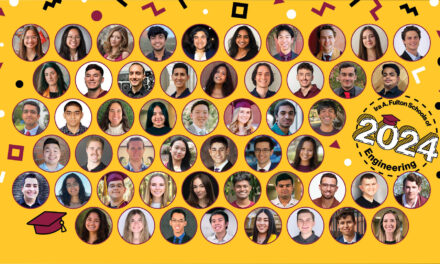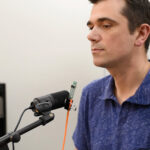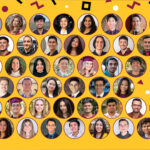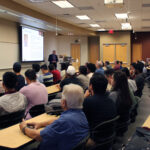
Senior projects prepare engineering students for workforce
Fulton Schools Capstone Showcase demonstrates students’ projects beyond the classroom
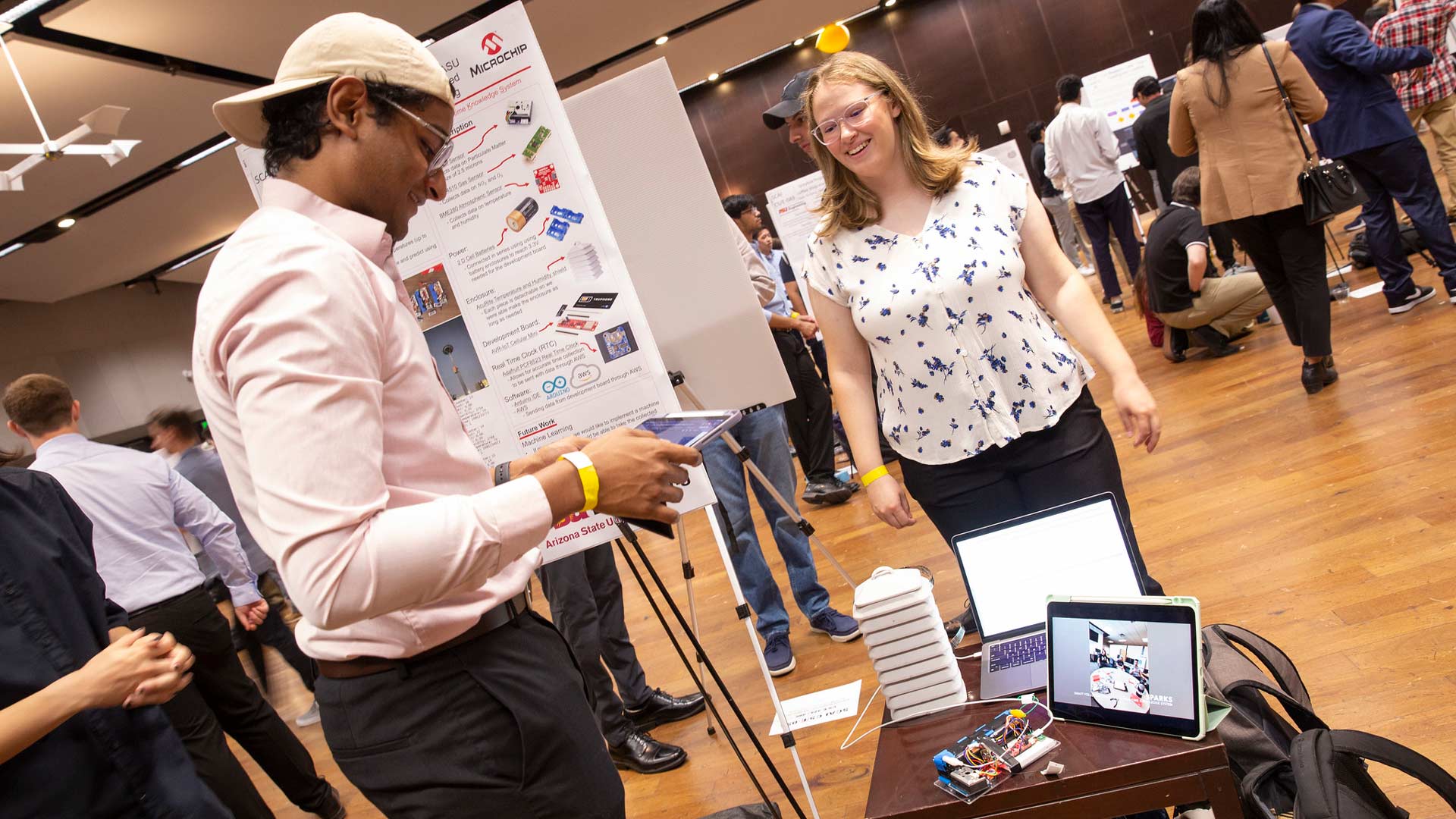
Graduating seniors from across the Ira A. Fulton Schools of Engineering at Arizona State University displayed their senior capstone projects at the Spring 2023 Fulton Schools Capstone Showcase.
The biannual event gives students the opportunity to show off their capstone projects, through which they gained real-world experience developing innovative solutions to societal problems and prepared to enter the workforce after graduation.
The event showcased approximately 260 projects from 1,200 students pursuing a range of degrees, including electrical engineering, mechanical engineering, materials science and engineering, computer science, computer systems engineering, informatics, industrial engineering, engineering management and biomedical engineering. These students represent the School of Computing and Augmented Intelligence, the School of Biological and Health Systems Engineering and the School for Engineering of Matter, Transport and Energy, all schools of the Fulton Schools.
Students were joined by faculty members, peers, industry sponsors, alumni and other guests to celebrate the completion of their projects and present their findings and results.
Teams worked collaboratively over the past two semesters to carry out ideas from initial designs through prototype fabrication, as well as testing and evaluation to validate their solutions. The students’ projects also considered issues related to ethics, economics, sustainability, security, safety and professional best practices in their design solutions.
“Students are getting experience in a low-risk environment where they’re able to develop professional and technical skills that aren’t part of our curriculum but are necessary for them to be marketable in their careers,” says Ryan Meuth, an associate teaching professor in the School of Computing and Augmented Intelligence who also leads the Capstone Showcase and coordinates the capstone projects for computer science and computer systems engineering students.
Meuth notes that the event acts as a pipeline for students to get hired after graduation. According to Meuth, one-third of students participating from the School of Computing and Augmented Intelligence get job offers at the Capstone Showcase event.
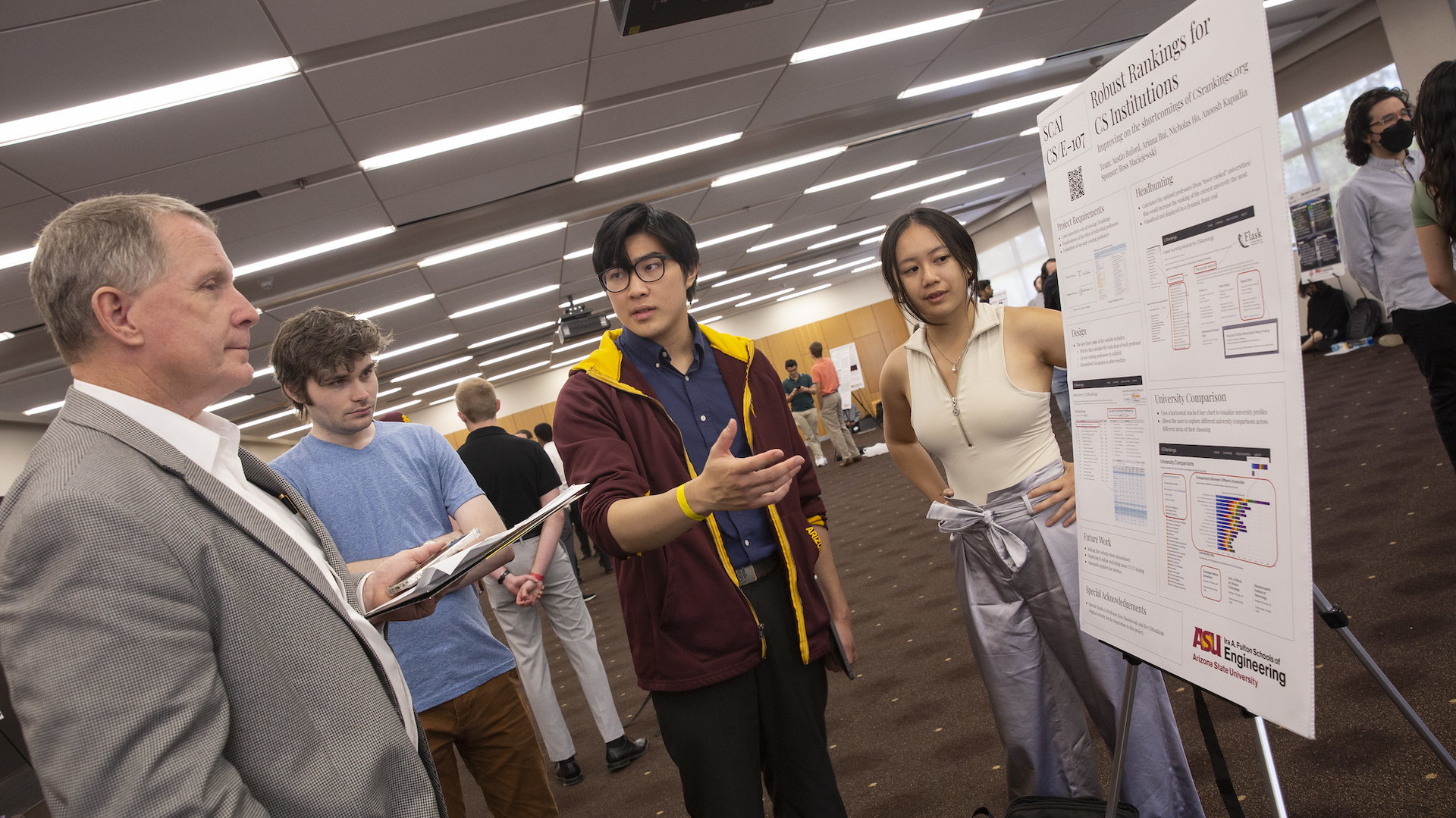
Students present their findings to a Capstone Showcase attendee. The event affords graduating seniors an opportunity to showcase their research to industry sponsors and mentors, securing postgraduation job offers for many students. Photographer: Erika Gronek/ASU
Analyzing air pollution
Computer systems engineering students Amber Kahklen, Carter Dunn, David Mangoli and Hunter White, along with computer science students Maxwell Calhoun and Tanishq Mor, completed a capstone project with industry sponsor Microchip Technology, a provider of microcontroller, mixed-signal, analog and Flash IP solutions.
The students addressed air quality and pollution in Tempe, creating an array of air sensors that test for particulate matter size, nitrogen dioxide, ozone, temperature and humidity parameters. Six sensors were placed across ASU’s Tempe campus to collect data, which the team then analyzed to identify areas that had the highest levels of pollution and what contributed to those conditions.
“With this data, we can identify the factors that contribute the most to air pollution across Tempe and make predictions to improve the problems,” Kahklen says. “We hope these sensors can be used to gauge traffic conditions and see what is contributing to air pollution, whether it’s stalled traffic, construction or another factor.”
The project, titled Smart Pollution Analysis and Real-time Knowledge System, or SPARKS, also considered the environmental impact of their findings.
“Sustainability and environmentalism were top priorities in our project,” Dunn says. “We were interested in bringing air quality data to light because it can be hard to access that information otherwise.”
The students worked with technical marketing engineers at Microchip Technology, including Ross Satchell, Toby Sinkinson and Nate Thompson.
“We gave the students a lot of creative freedom within the project, so they had to work together and define a lot of the information themselves, going through academic papers to figure out what sensors to use and which atmospheric pollutants to be concerned about,” Satchell says. “The students are always wonderful to work with. This is the fourth Capstone Showcase that I’ve been involved in.”
For Satchell, a Fulton Schools alumnus, participating in the capstone course as an industry sponsor is a full-circle moment. He participated as a student in 2018 and was hired by Microchip Technology because of the event. Sinkinson is also a Fulton Schools alumnus and participated in the Capstone Showcase in 2022, where he was hired by Satchell.
Sinkinson and Satchell are eager to find an outlet to move the students’ SPARKS innovation forward to find a real-world application for the project.
“We go to trade shows often and engage in demos for industry members to show what our technologies can do,” Sinkinson says. “We’re hoping to pitch this project to local governors and see how we can work together to apply this research to sequencing traffic lights and analyzing the baseline of current air quality.”

The Smart Pollution Analysis and Real-time Knowledge System, or SPARKS, team presents their project results at the Capstone Showcase. They analyzed air quality and pollution across Tempe in a project sponsored by Microchip Technology. Photographer: Erika Gronek/ASU
Automating semiconductor manufacturing processes
Mechanical engineering seniors Daniel Adamo, Sameer Naguib, Kelly Tolman, Kayla Johnson and Adam Griffith also collaborated with an industry sponsor for their capstone project. The team worked with Intel to improve a step in their circuit board manufacturing process, developing a prototype to automate the fastening of the heatsink to the board.
This crucial step is typically done manually with a torque driver. Automating the process increases the step’s accuracy during manufacturing.
The heatsink is a vital component in hardware, helping cool circuit boards as they generate heat during operation. Managing their temperature achieves optimal performance.
“When Intel approached us with this project, they had an automatic tool to help with this step, but it only used a single motor. It was facing an issue where it was not torquing all the individual screws the same amount,” Naguib says. “Our prototype has four separate drivers that allow us to determine programmatically if all the screws are torqued to the right specifications.”
Adamo says his team contributed improvements beyond adding more motors.
“We also included a proximity sensor, which can sense metal within five millimeters and is the most pivotal part of our design,” Adamo says. “A separate motor raises the boards up to the drivers, and the proximity sensor sees the Intel product, communicates to the motor to stop, delays a couple of seconds and then activates the main drivers to operate once it has identified the correct position.”
As former Intel interns, Naguib and Adamo have experience working closely with the company and understand throughput is a top priority.
“They want to make sure products are moving as fast as possible while maintaining the same level of quality,” Adamo says. “This prototype can help simplify the microelectronics manufacturing process while making it faster and more precise.”
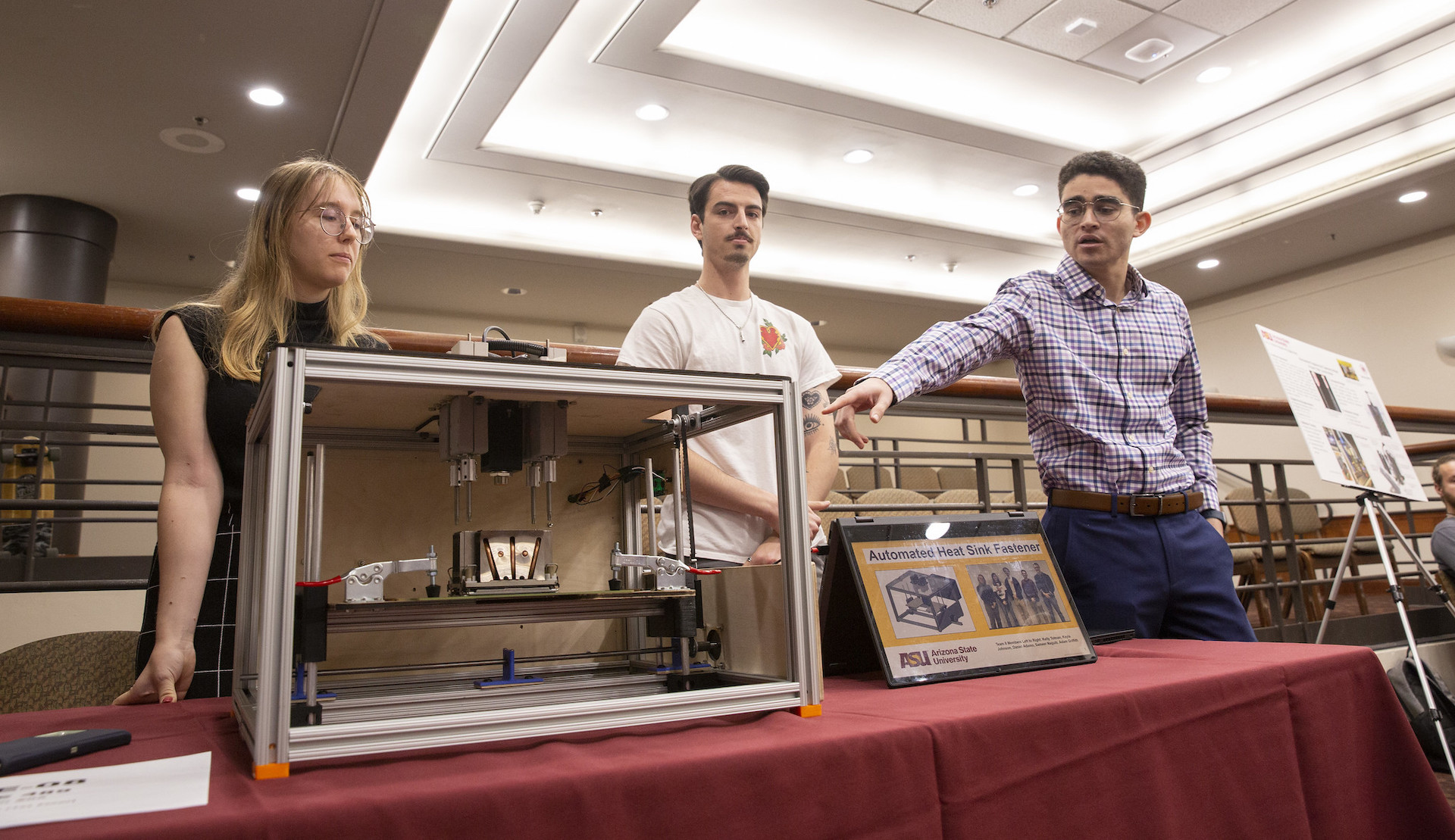
The Automated Heat Sink Fastener team demonstrates their project at the Capstone Showcase. The team worked with industry sponsor Intel on a prototype to improve a step in the semiconductor manufacturing process. Their efforts won them one of two School for Engineering of Matter, Transport and Energy Best in Showcase awards. Photographer: Erika Gronek/ASU
Award-winning research
The most compelling student presentations and their associated projects were also honored with Best in Showcase awards and a $500 cash prize, funded by an anonymous Fulton Schools alumnus. One project per school received an award, with the School for Engineering of Matter, Transport and Energy splitting its prize money between two projects that tied.
The Automated Heat Sink Fastener project was one of those two. The other winning project was the Dual Powered Energy Water Purifier.
Led by team members Seth Randall, Wilson Ooi, Tasnia Hossain, Riley Ober, Daniel Martinez and Mauricio Pinon Molina, the Dual Energy Energy Water Purifier project displayed a water purification system powered by two sources: electrical and solar irradiance. The team’s prototype purifies water using an evaporation and condensation cycle.
The School of Computing and Augmented Intelligence Best in Showcase award went to a team consisting of Zachary Smith, Elizabeth Arnold and Anna Mendenhall, who developed a vehicle autopilot program to use with the ASU Luminosity Lab’s preexisting hybrid electric vehicle. The goal of the project, called Trident One, was to develop a vehicle autopilot program capable of Level 3 automation. Level 3 automation means the system can perform all driving tasks for the vehicle, while enabling the driver to take over when requested.
The winners of the School of Biological and Health Systems Engineering Best in Showcase award included seniors Dhrasti Dalal, Alan Ramsey, Derek Smetanick, Ashley Tse and Shaun Victor. Their project, titled Developing an Implantable Electrode to Treat Spasmodic Dysphonia, was sponsored by Mayo Clinic. The team created an implantable electrode for the laryngeal nerve to treat a condition called spasmodic dysphonia, a neurological disorder that causes laryngeal muscle spasms, resulting in irregular speech.

In addition to displaying posters about their capstone projects, many students showcased physical components of their work for guests to try out in person, like this virtual reality headset. Photographer: Erika Gronek/ASU
More Fulton Schools student innovation
Students across the Fulton Schools also had opportunities to showcase their senior capstone projects in several other events happening at ASU.
The School of Electrical, Computer and Energy Engineering, part of the Fulton Schools, held a senior capstone project event called Demo Day. Forty-nine teams demonstrated projects spanning a variety of facets of electrical engineering, such as machine learning, solar technology, power electronics, health care and more.
Eight of the teams competed for the Joseph and Sandra Palais Senior Design Award, which recognizes an outstanding capstone project with a celebratory lunch and cash prize.
At the Polytechnic campus, Fulton Schools students presented their senior capstone projects at the Innovation Showcase. This semester’s showcase hosted a record 123 projects and represented students in three of the seven Fulton Schools: The Polytechnic School, the School of Manufacturing Systems and Networks and the School of Computing and Augmented Intelligence.
Students in programs such as aviation, embedded systems design, Engineering Projects in Community Service, human systems engineering, information technology, manufacturing engineering, mechanical engineering systems, software engineering, SolarSPELL and more showcased their end-of-semester and capstone projects, many of which were sponsored by industry, to faculty, staff, industry, alumni and future Sun Devils.

A group of students poses for a photo at the Capstone Showcase. The event gives seniors an opportunity to show off their solutions to real-world problems and prepare for the workforce before graduation. Photographer: Erika Gronek/ASU






